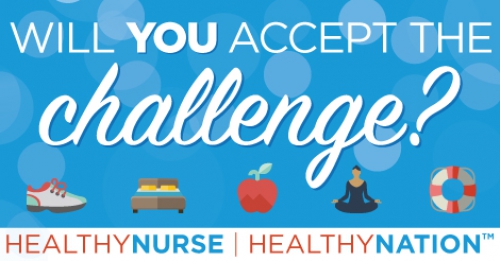Healthy Nurse, Healthy Nation® Blog: Empowering Nurse Wellbeing Through Artificial Intelligence: A New Era in Workforce Support
Published
By Jennifer Shepherd
 As healthcare systems face increasing pressure from workforce shortages, rising patient complexity, and post-pandemic fatigue, nurse wellbeing has emerged as a critical priority. Burnout, moral distress, and mental health challenges are impacting not only nurses' personal lives but also patient safety and organizational performance. Amid these growing concerns, healthcare leaders are turning to innovative strategies—including artificial intelligence (AI)—to support and sustain the wellbeing of the nursing workforce.
As healthcare systems face increasing pressure from workforce shortages, rising patient complexity, and post-pandemic fatigue, nurse wellbeing has emerged as a critical priority. Burnout, moral distress, and mental health challenges are impacting not only nurses' personal lives but also patient safety and organizational performance. Amid these growing concerns, healthcare leaders are turning to innovative strategies—including artificial intelligence (AI)—to support and sustain the wellbeing of the nursing workforce.AI is often discussed in the context of clinical decision support or administrative automation, but its potential to enhance wellbeing is equally compelling. By reducing burdensome tasks, personalizing wellness interventions, and expanding access to mental health support, AI is poised to become a powerful ally in nurse wellness initiatives.
The Nurse Wellbeing Imperative
According to a 2023 report by the American Nurses Foundation, 56% of nurses reported feeling emotionally drained at least a few times a week, and 64% experienced work-related stress or burnout symptoms¹. Wellbeing is no longer a “nice-to-have”—it is a strategic imperative. A well-supported nursing workforce is directly linked to improved patient outcomes, lower turnover, and more resilient healthcare environments².
AI for Administrative Relief
One of the most immediate ways AI supports nurse wellbeing is by relieving administrative burdens. Natural language processing (NLP) tools, like ambient clinical documentation systems, capture and transcribe nurse-patient interactions in real time, reducing the hours nurses spend charting³. AI-driven scheduling platforms optimize shift assignments to align with nurses’ preferences and workload patterns, promoting work-life balance⁴. These tools help reduce cognitive fatigue and allow nurses to focus more on what matters most—caring for patients.
Emotional and Mental Health Support
AI-powered chatbots and mental health apps are providing nurses with on-demand emotional support, mindfulness exercises, and CBT-based tools. These virtual assistants can be accessed anonymously, breaking down stigma and creating a safe space to process stress⁵. Some systems are piloting AI models trained to detect signs of burnout using language and behavior cues, prompting timely self-care interventions or referrals to human support⁶.
Importantly, these tools must be designed ethically—ensuring privacy, promoting equity, and complementing (not replacing) human-centered support systems⁷.
Personalized and Proactive Wellbeing
AI also enables proactive wellness strategies through personalization. Wearables paired with AI monitor metrics like heart rate variability or sleep quality, offering real-time prompts for hydration, movement, or breathing exercises⁸. Predictive analytics can identify staff at high risk for burnout and prompt wellness coaching or peer support interventions⁹. These strategies show promise in cultivating a supportive and responsive work environment.
Looking Ahead: A Call to Action
AI’s potential to enhance nurse wellbeing is promising—but it requires thoughtful, inclusive implementation. While AI tools can streamline tasks, reduce cognitive load, and support clinical decision-making, they are not a panacea. Solutions must be co-designed with nurses, protect privacy, and align with core professional values to be effective and ethical. It’s vital to follow your organization’s AI policies, recognize that AI is not the final word, and always verify outputs for accuracy and relevance. Used responsibly, AI can support nursing practice and wellbeing—but only with human oversight, critical thinking, and a commitment to safe, values-driven care.
Now is the time for healthcare leaders, nurse innovators, and technology developers to collaborate. By leveraging AI not only to optimize operations but also to uplift the workforce, we can foster a future where nurses thrive—and, in turn, deliver the highest quality care to the communities they serve.
Jennifer Shepherd, DNP, MHA, RN, NEA-BC, NPD-BC, is the Director of Healthy Nurse, Healthy Nation and Nursing Practice & Work Environment at the American Nurses Association.
Do you use any AI tools in your role as a nurse? How are they helpful? Tell us in the discussion below.
- American Nurses Foundation. (2023). Pulse on the Nation’s Nurses Survey Series: Mental Health and Wellness. https://www.nursingworld.org/practice-policy/work-environment/health-safety/disaster-preparedness/coronavirus/what-you-need-to-know/mental-health-and-wellbeing-survey/
- National Academy of Medicine. (2019). Taking Action Against Clinician Burnout: A Systems Approach to Professional Well-Being. https://doi.org/10.17226/25521
- Botaine, C. (2024). Ambient Listening and NLP Technologies Revolutionize Healthcare Workflows. Retrieved from Ambient Listening and NLP Technologies Revolutionize Healthcare Workflows | Healthtech Curated
- Dailah, H. et al. (2024). Artificial Intelligence in Nursing: Technological Benefits to Nurse's Mental Health and Patient Care Quality. Healthcare (Basel, Switzerland), 12(24), 2555. https://doi.org/10.3390/healthcare12242555
- Bieri J. et al. (2024). Natural Language Processing for Work-Related Stress Detection Among Health Professionals: Protocol for a Scoping Review. JMIR Res Protoc 2024;13:e56267. doi: https://doi.org/10.2196/56267
- American Nurses Association (2025) Code of Ethics for Nurses. Retrieved from 2025 Code of Ethics for Nurses | American Nurses Enterprise
- Day, M. (2025). Wearable Tech in Healthcare: Opportunities and Challenges. Retrieved from Wearable Tech in Healthcare: Opportunities and Challenges - Interwoven
- Carayon, P., & Wetterneck, T. B. (2020). Improving Safety and Wellbeing Through Human Factors and Predictive Analytics. BMJ Quality & Safety, 29(3), 200–202.
Not a member of Healthy Nurse, Healthy Nation (HNHN) yet? Join today!
Join our monthly challenges at hnhn.org/challenges.
Join our monthly challenges at hnhn.org/challenges.
Blog Quality of Life
06/04/2025 8:28am CDT




Post a Comment or Question